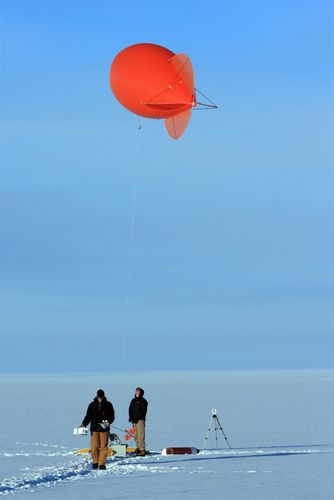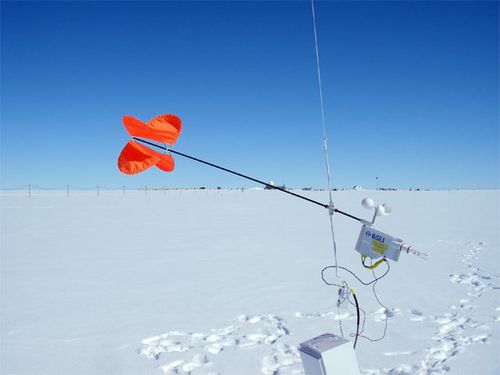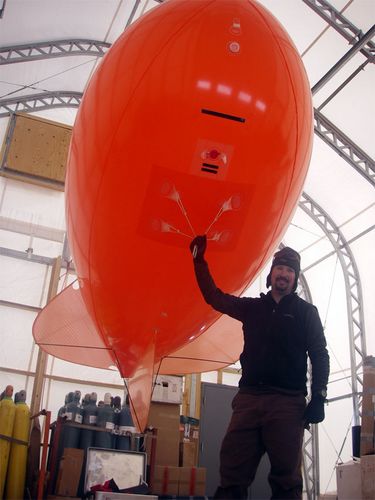June 21, 2008 – Finding Nemo
Let me apologize now. This is a long journal. I don’t know what happened, my fingers just kept typing…sorry. Anyway, for those of you who just look at the pictures (you know who you are), you won’t have to worry about all the words. For those of you who actually read these things, get comfortable. Pull up a cozy chair, start a fire, throw a blanket over your lap and get ready to spend the next few minutes of your life learning about research in the Arctic…
The atmospheric group (our team) has entered our IOP (Intense Operational Period). The wind has calmed down and the conditions are ripe for analyzing the properties of the atmosphere, and this team is well equipped to study the atmosphere.

Our primary tool is the Tethersonde. The tethersonde is basically a small blimp shaped balloon that is filled with helium to make it lighter than air. The "tether” part comes from the fact that it is attached (tethered) to a winch on the ground that can be controlled to allow the balloon to rise up into the sky, or lowered back down to the ground. The "sonde” part of the name refers to the instrument that is attached below the blimp and gives us information about the air up there. It, the instrument, sends back a radio signal to an antenna we attached to the top of Captain Jack’s Shack in Sat Camp. The antenna brings the information inside to a computer that interprets the data and gives us information like: Temperature, wind direction, wind speed, relative humidity (moisture in the air), dew point (temperature where the water in the sky turns into cloud or rain droplets), and much, much more! It is an impressive machine that is amazingly simple in design. It is easier to look at a picture to understand what the instrument looks like so I posted one below.

When the weather permits, Craig Clements, Barry Lefer and I spend most of our days (and sometimes nights) at Sat Camp raising and lowering "Nemo” high up into the sky, then bringing it back down to the surface. ("Nemo” is what Craig Clements likes to call the blimp. He thinks it looks like the famous Disney clown fish, I would have to agree!)
I can here you asking, "Why do you raise it up into the sky?” To which I reply, "The whole team up here is looking at how sunlight interacts with gasses in the air and snow; things like OzoneOzone is a molecule made up of three atoms of oxygen. Ozone occurs naturally in the stratosphere and provides a protective layer shielding the Earth from harmful ultraviolet radiation. In the troposphere (the lower layer of the atmosphere up to approximately 15 km above the earth's surface), it is a chemical oxidant, a greenhouse gas, and a major component of photochemical smog., and Nitrogen Oxide, and Carbon Dioxide. They would like to know how those gasses are changed by the sunlight? But, before you can answer the question about the sunlight, you have to figure out where these chemicals are coming from. The tethersonde tells us how the air above our heads is moving because it is hard to see air move (unless it has a cloud moving with it). The information from the blimp tells the scientists if the chemicals and gasses are coming from factories in the US, or from evaporated sea water, or from…well…there are a million possibilities. That is what makes their job so difficult (and interesting).”
Sometimes it is easy to think that science has all the answers. That everything has been figured out, when really there is so much to learn about our planet. Up here there is less ozone that the scientists would expect. They are trying to figure out how this could possibly be. Nobody has an answer...yet! "Nemo” is one tool the scientists use to help answer this and other important questions!
The tethersonde has its own special home too. When it isn’t flying high at Balloon Island (that is what we call the launch site) it is stored away quietly in the "Balloon Barn”. The Balloon Barn is a large fabric covered "garage” type structure where Nemo can hide out during the intense storms that often blow through Summit.

Food Update:
Lunch: Fajitas with steak, onions and peppers, fish fajita meat, refried beans, tortillas, rice, and anything you can imagine putting on top of fajitas.
Dinner: Cranberry Orange Glazed Pork, Baked Veggie Polenta with Gouda Cheese, Butternut Squash stuffed with Rice, Porcini ‘shrooms and soy, Buttered Edemame with shallots.
By the way, Happy Summer Solstice! Today is the longest day of the year and is the start of summer! Woo Hoo! It is a big deal, and a rite of passage (so they say) to spend the solstice above the Arctic Circle, and here we are! Tomorrow is the big celebration at Summit Camp, Greenland! There is a sick rumor going around camp that tomorrow night’s dinner might be lobster, shrimp and steak…the old "Surf and Turf”! Believe me…I’ll keep you updated!
Stay Warm!!


Comments